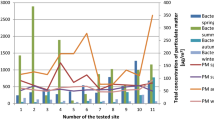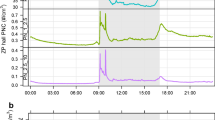Abstract
Cultural heritage objects are very frequently visited by tourists, the presence of which is considered to affect the bacterial and fungal aerosol levels in these facilities. Therefore, this study had two main aims with the first to determine the morning/evening changes in the concentration of bacterial and fungal aerosol as well as particulate matter in the selected historical objects of Kraków: churches, crypts, libraries, and museums. The second aim was to establish the most possible factors affecting the quality of air in the examined sites using data mining techniques: principal component analysis (PCA) and cluster analysis (CA). Bacterial and fungal aerosol levels were measured in ten historical objects by six-stage Andersen impactor. Particulate matter (PM10, PM4, PM2.5 and PM1), temperature, and relative humidity (RH) were also assessed. Unlike dusts, the microbial aerosol concentrations were not always significantly lower in the morning than in the evening. For bacteria, these relationships varied depending on the site, while for fungi, the morning concentrations were mostly higher than the evening ones. Both PCA and CA indicated that the bacterial and fungal aerosol concentrations were not associated with the particulate matter levels, which might suggest different sources of those two air pollution components. Temperature and RH appear to be more important in shaping the microbial aerosol levels and fungi are more dependent on RH than bacteria.





Similar content being viewed by others
References
Bonetta, S. A., Bonetta, S. I., Mosso, S., Sampò, S., & Carraro, E. (2010). Assessment of microbiological indoor air quality in an Italian office building equipped with an HVAC system. Environmental Monitoring and Assessment, 161, 473–483. https://doi.org/10.1007/s10661-009-0761-8.
Burge, H. A., & Otten, J. A. (1999). Fungi. In: Bioaerosols: Assessment and control (Macher J., ed.). Cincinatti, OH: American Conference of Governmental Industrial Hygienists, 19-11–19-13.
Chao, H. J., Schwartz, J., Milton, D. K., & Burge, H. A. (2002). Populations and determinants of airborne fungi in large office buildings. Environmental Health Perspectives, 110(8), 777–782.
Chen, C., & Zhao, B. (2011). Review of relationship between indoor and outdoor particles: I/O ratio, infiltration factor and penetration factor. Atmospheric Environment, 45, 275–288. https://doi.org/10.1016/j.atmosenv.2010.09.048.
Chen, Y., Cui, Y., & Dong, J. (2010). Variation of airborne bacteria and fungi at Emperor Qin’s Terra-Cotta Museum, Xi’an, China, during the “Oct. 1” Gold Week Period of 2006. Environmental Science and Pollution Research, 17, 478–485.
Chmiel, M., Kral, I., & Lenart-Boroń, A. (2019). Concentration and size distribution of microbial aerosol in the historical objects in Kraków as a potential health risk and biodeterioration factor. Aerobiologia, 35(4), 743–758.
Ciferri, O., Becker, M. E., & De Rossi, E. (2003). Characterization of bacteria isolated from naturally aged silk fibroin. In R. J. Koestler, V. H. Koestler, A. E. Charola, & F. E. Nieto-Fernandez (Eds.), Art, biology, and conservation: Biodeterioration of works of art (pp. 190–207). New York: Yale University Press.
Dutkiewicz, J., & Górny, R. L. (2002). Biological factors hazardous to human health: Classification and criteria of exposure assessment. Medycyna Pracy, 53(1), 29–39. (in Polish).
Dybwad, M., Skogan, G., & Blatny, J. M. (2014). Temporal variability of the bioaerosol background at a subway station: Concentration level, size distribution and diversity of airborne bacteria. Applied and Environmental Microbiology, 80(1), 257–270.
Erkara, I. P., Asan, A., Yilmaz, V., Pehlivan, S., & Okten, S. S. (2008). Airborne Alternaria and Cladosporium species and relationship with meteorological conditions in Eskisehir City, Turkey. Environmental Monitoring Assessment, 144, 31–41.
Fakunle, A. G., Olusola, B., Jafta, N., Faneye, A., et al. (2020). Home Assessment of Indoor Microbiome (HAIM) in relation to lower respiratory tract infections among under-five children in Ibadan, Nigeria: The Study Protocol. International Journal of Environmental Research and Public Health, 17(6), 1857. https://doi.org/10.3390/ijerph17061857.
Frąk, M., Majewski, G., & Zawistowska, K. (2014). Analysis of the quantity of microorganisms adsorbed on particulate matter PM10. Scientific Review – Engineering and Environmental Sciences, 64, 140–149. (in Polish).
Fujiyoshi, S., Tanaka, D., & Maruyama, F. (2017). Transmission of airborne bacteria across built environments and its measurement standards: A review. Frontiers in Microbiology, 8, 2336.
Gajewska, M., & Głowacka, A. (2017). Assessing filamentous fungal contamination of dried herbs and spice available in retail health food stores and hypermarkets. Food Science Technology Quality, 24(3), 51–59.
Ghajari, A., Lotfali, E., Azari, M., Fateh, R., & Kalantary, S. (2015). Fungal airborne contamination as a serious threat for respiratory infection in the hematology ward. Tanaffos, 14(4), 257–261.
Gołofit-Szymczak, M., Ławniczek-Wałczyk, A., & Górny, R. L. (2013). Exposure of ventilation system clearing workers to harmful microbiological agents. Medycyna Pracy, 64(5), 613–623. https://doi.org/10.13075/mp.5893.2013.0066.
Górny, R. L. (2004). Biohazards: standards, guidelines, and proposals for threshold limit values. Podstawy i Metody Oceny Środowiska Pracy, 3(41), 17–39.
Górny, R. L., Cyprowski, M., Ławniczek-Wałczyk, A., Gołofit-Szymczak, M., & Zapór, L. (2011). Biohazard in the indoor environment: A role for threshold limit values in exposure assessment. In M. R. Dudzińska (Ed.) Management of indoor air quality. Taylor & Francis Group, 1–20.
Harkawy, A., Górny, R. L., Ogierman, L., Wlazło, A., et al. (2011). Bioaerosol assessment in naturally ventilated historical library building with restricted personnel access. Annals of Agricultural and Environmental Medicine, 18(2), 323–329.
Husman, T., Koskinen, O., Hyvakrinen, A., Reponen, T., et al. (1993). Respiratory symptoms and infections among residents in dwellings with moisture problems or mould growth. In Kalliokoski, P., Jantunen, M., SeppaK nen, O. (Eds.) Proceedings of Indoor Air ‘93, vol. 4.Helsinki, Finland, pp. 171–174.
Karbowska-Berent, J., Górny, R. L., Strzelczyk, A. B., & Wlazło, A. (2011). Microbial air quality in selected Polish libraries and archives. Building and Environment, 46, 1872–1879.
Kowalski, M., & Pastuszka, J. S. (2018). Effect of ambient air temperature and solar radiation on changes in bacterial and fungal aerosols concentration in the urban environment. Annals of Agricultural and Environmental Medicine, 25(2), 259–261.
Lazaridis, M., Katsivela, E., Kopanakis, I., Raisi, L., & Panagiaris, G. (2015). Indoor/outdoor particulate matter concentrations and microbial load in cultural heritage collections. Heritage Science, 3, 34. https://doi.org/10.1186/s40494-015-0063-0.
Lehtonen, M., & Reponen, T. (1993). Everyday activities and variation of fungal spore concentrations in indoor air. International Biodeterioration and Biodegradation, 31, 25–39.
Leung, D. Y. C. (2015). Outdoor-indoor air pollution in urban environment: Challenges and opportunity. Frontiers in Environmental Science. https://doi.org/10.3389/fenvs.2014.00069.
Ławniczek-Wałczyk, A., Cyprowski, M., Gołofit-Szymczak, M., Wójcik-Fatla, A., et al. (2018). Assessment of fungal aerosol exposure at selected workplaces contaminated with organic dust of different origin. Medycyna Pracy, 69(3), 269–280.
Mehta, S., Kambli, P., Wani, K., Tanavde, S., et al. (2013). Study of bio-aerosols in a prominent temple in Mumbai City, India. International Journal of Environmental Studies. https://doi.org/10.1080/00207233.2013.829323.
Napoli, Ch., Marcotrigiano, V., & Montagna, M. T. (2012). Air sampling procedures to evaluate microbial contamination: A comparison between active and passive methods in operating theatres. BMC Public Health. https://doi.org/10.1186/1471-2458-12-594.
Pastuszka, J. S., Paw, U. K. T., Lis, D. O., Wlazło, A., & Ulfig, K. (2000). Bacterial and fungal aerosol in indoor environment in Upper Silesia, Poland. Atmospheric Environment, 34, 3833–3842.
Salma, I., Weidinger, T., & Maenhaut, W. (2007). Time-resolved mass concentration, composition and sources of aerosol particles in a metropolitan underground railway station. Atmospheric Environment, 41, 8391–8405.
Skowroń, J. (2014). The activity of the Interdepartmental Commission for Maximum Admissible Concentrations and Intensities for Agents Harmful to Health in the Working Environment in 2011–2013. Podstawy i Metody Oceny Środowiska Pracy, 1(79), 161–184. (in Polish).
Skóra, J., Gutarowska, B., Pielech-Przybylska, K., Stępień, L., et al. (2015). Assessment of microbiological contamination in the work environments of museums, archives and libraries. Aerobiologia, 31, 389–401.
Spilak, M. P., Madsen, A. M., Knudsen, S. M., Kolarik, B., et al. (2015). Impact of dwelling characteristics on concentrations of bacteria, fungi, endotoxin and total inflammatory potential in settled dust. Building and Environment, 93(1), 64–71.
Sroka, P., Cyprowski, M., & Szadkowska-Stańczyk, I. (2008). Occupational exposure to mycotoxins in various branches of industry. Medycyna Pracy, 59(4), 333–345. (in Polish).
Stetzenbach, L. D., Buttner, M. P., & Cruz, P. (2004). Detection and enumeration of airborne biocontaminants. Current Opinion in Biotechnology, 15(3), 170–174.
Tang, J. W. (2009). The effect of environmental parameters on the survival of airborne infectious agents. Journal of Royal Society Interface, 6, S737–S746.
Zhai, Y., Li, X., Wang, T., Wang, B., et al. (2018). A review on airborne microorganisms in particulate matters: composition, characteristics and influence factors. Environment International, 113, 74–90.
Funding
This study was funded by the statutory measures of the University of Agriculture—Grant No. DS 3158/KM.
Author information
Authors and Affiliations
Contributions
Maria Chmiel and Anna Lenart-Boroń contributed to research concept and design. Maria Chmiel conducted sample collection, data generation and critical revision of the article as well as final approval of the article text. Anna Lenart-Boroń conducted data interpretation and analysis, writing of article and figure preparation.
Corresponding author
Rights and permissions
About this article
Cite this article
Chmiel, M., Lenart-Boroń, A. Morning–evening variation and determinants of bacterial and fungal aerosol concentration in historical objects in Kraków. Aerobiologia 37, 253–270 (2021). https://doi.org/10.1007/s10453-020-09687-z
Received:
Accepted:
Published:
Issue Date:
DOI: https://doi.org/10.1007/s10453-020-09687-z




